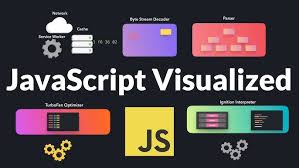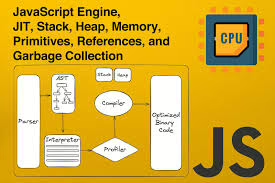The code you’ve crafted successfully compiles and runs in your browser, bringing your stunning web application to life. But have you ever considered the various elements that work behind the scenes to produce this result? Let’s take a closer look at what happens with JavaScript under the hood—the less visible yet crucial aspects. You might wonder why delving into this seemingly abstract topic is significant for you. Gaining insight into how JavaScript operates enables you to dig deeper into the language, moving beyond a superficial understanding. It equips you with valuable context regarding JavaScript and illustrates how its engine optimises your code. This foundational knowledge can profoundly influence your coding practices, leading to more efficient, scalable, and maintainable solutions.

At its core, the JavaScript engine is merely a computer program designed to interpret and execute JavaScript code. Each major web browser comes equipped with its own JavaScript engine responsible for running scripts. Among these engines, Google’s V8 stands out as one of the most widely used; it powers both Google Chrome and Node.js—a back-end runtime environment that facilitates server-side application development.
Several significant browser engines play a crucial role in web development. Among them are SpiderMonkey, crafted by Mozilla for Firefox; JavaScriptCore, which fuels the Safari browser; and Chakra, the engine behind Internet Explorer. Each JavaScript engine typically comprises two key components: a call stack and a heap. The call stack is where code execution takes place, while the heap serves as an unstructured memory reservoir that holds all necessary objects for an application.

Given that a computer’s processor operates solely on binary—comprising 0s and 1s—the code must be converted into this format. When a snippet of code enters the engine, it undergoes an initial phase known as parsing, during which it is read. Following this step, the code is transformed into a data structure referred to as the abstract syntax tree (AST). This tree then facilitates the creation of machine codes.
The callback queue is a collection of functions waiting to be executed. It operates on a First-In-First-Out (FIFO) basis, ensuring that the earliest callbacks are processed first, and these functions are transferred to the call stack only when it is free. Examples of environments where JavaScript runs include browser runtimes and Node.js. When JavaScript is executed in a web browser, it utilises the browser’s runtime environment, which allows access to the Document Object Model (DOM). This access facilitates interactions with elements on a web page, manages events, and alters the structure of the page itself. On the other hand, Node.js serves as a server-side runtime for executing JavaScript beyond the confines of a browser. Since it operates outside of this context, it lacks direct access to web APIs; instead, it employs C bindings and utilises a thread pool.
To enhance code execution performance, modern JavaScript engines implement various optimisation strategies that take place dynamically during execution. One essential technique is Just-in-Time (JIT) compilation, which translates JavaScript code into machine code through both compilation and interpretation methods. In this process, rather than converting code line by line or in small increments as it runs, JIT compilation translates all source code at once into machine-readable binary files for efficient execution by the computer.
The actual execution occurs within the JavaScript engine’s call stack through what’s known as the execution context—the environment in which JavaScript code runs.

Now, envisioning the JavaScript runtime can be likened to imagining a house filled with everything required to operate JavaScript effectively. This house includes not only the JavaScript engine but also Web APIs and a callback queue. The Web APIs provide functionalities that augment what’s available in standard JavaScript; they are accessible via the browser and assist in retrieving data or enhancing overall browser capabilities. Notable examples include features like the Document Object Model (DOM) and Fetch APIs.
Imagine a visual representation illustrating the process of code compilation. Unlike compilation, interpretation involves an interpreter that reads through the source code, executing it one line at a time as it progresses. Now, picture another diagram that depicts the process of code interpretation. Historically, JavaScript was classified as an interpreted language; however, interpreted languages tend to be slower than their compiled counterparts. To enhance the performance of web applications, JavaScript has adopted a hybrid approach that incorporates both compilation and interpretation techniques known as Just-in-Time (JIT) compilation. This innovative method compiles all the code into a machine-readable format in one go before executing it.

Visualise yet another diagram showcasing how Just-in-Time compilation works. JIT shares similarities with traditional compilation processes; however, in this case, machine code is not stored in a binary file—it is executed immediately after being compiled. This approach has notably improved the execution speed of JavaScript code, helping to clarify any misconceptions about JavaScript being solely an interpreted language.
To maximise optimisation in JavaScript execution, the engine first generates an unoptimised version of machine code to facilitate immediate execution. While this initial version runs, further optimisations and recompilations take place behind the scenes during program execution. This iterative process continues until the most refined and efficient version is achieved.
Parsing, compiling, and executing occur within a specialised thread inside the engine that remains inaccessible from regular code execution.

Now, let’s explore Inlining—another performance enhancement technique used by JavaScript to boost efficiency and speed. Consider this simple function:
“`javascript
function add(a, b) {
return a + b;
}
let result = 0;
result += add(5);
result += add(3);
console.log(result);
“`
In this example snippet, rather than calling the original `add()` function directly each time it’s needed, JavaScript inserts its internal logic (`return a + b;`) right where it’s called instead. This particular optimisation is especially beneficial for functions that are invoked repeatedly throughout your program’s runtime.
In this example, the add() function isn’t invoked in the usual manner. Instead, the code that defines what add() does—expressly, a + b—is directly incorporated where the function is called. This technique is particularly beneficial for functions that are executed multiple times. The JavaScript engine processes the function as it typically would; however, when it recognises that a function is being called frequently, it substitutes the actual code of that function right at its call site. This substitution minimises the number of times functions are called and enhances overall performance.
When considering the performance aspects of your web application, various elements come into play. While the JavaScript engine employs various optimisation tactics, developers should also adhere to certain best practices to ensure efficient execution. For instance, reducing interactions with the DOM and limiting function calls can significantly boost code efficiency. Excessive DOM access and manipulation can slow down webpage rendering and lead to noticeable performance issues. Although altogether avoiding DOM interactions isn’t feasible, you can lessen their impact by batching updates to reduce overhead.

Moreover, cutting down on unnecessary function calls elevates performance further. Streamlining your code in this way not only enhances efficiency but also makes your JavaScript applications quicker and more responsive.
To illustrate this point with an example of inefficient versus improved code:
Consider this less efficient version:
“`javascript
function calculateTotal(a, b, c) {
return addNumbers(a, b) + multiply numbers(c, b);
}
function addNumbers(x, y) {
return x + y;
}
function multiplyNumbers(x, y) {
return x * y;
}
“`
Here, `calculateTotal()` separately invokes `addNumbers()` and `multiplyNumbers()`, leading to overhead from these additional calls.
Now look at how we can improve it:
“`javascript
function calculate total(a, b, c) {
const sum = a + b;
return sum + c * b;
}
console.log(calculateTotal(2, 3, 4)); // Output: 23
“`
In this optimised version of `calculateTotal()`, we eliminate those extra function calls by performing arithmetic operations directly within the function body itself. This not only simplifies our logic but also enhances performance significantly by reducing the overhead associated with multiple calls.
The Future of JavaScript: Trends and Innovations
As we look ahead, the landscape of JavaScript is set to evolve with ongoing enhancements in its engines and runtime environments. These innovations aim to boost the performance of web applications significantly. A key player in this evolution is WebAssembly, which offers near-native speed for web applications and accommodates various programming languages. This opens up exciting avenues for optimising performance and accelerating execution times.
For JavaScript developers, keeping abreast of these developments is crucial. Embracing new coding practices that align with these trends will be essential for staying competitive in a rapidly changing environment.
Conclusion
The journey from your JavaScript code to a fully functional web application involves a multitude of processes. This article has provided a broad overview of the essential concepts at play. It delves into how the JavaScript engine interprets code, the intricacies of the runtime, and its various components. Additionally, it discusses optimisation strategies while emphasising key performance factors.

Gaining insight into the inner workings of JavaScript not only influences how developers tackle challenges but also enables them to write more efficient code. This understanding equips them to navigate future changes in JavaScript features with confidence.
How Maxthon Runs JavaScript
- Launch Maxthon Browser: Open the Maxthon browser on your device. Ensure you have the latest version installed for optimal performance.
- Engage the JavaScript Engine: Maxthon leverages a sophisticated JavaScript engine called V8, which is known for its speed and efficiency. This engine compiles JavaScript code into executable machine code, enhancing runtime performance.

- Load Web Pages: When you navigate to a website, the browser downloads HTML, CSS, and JavaScript files from the server. These files are crucial for rendering dynamic content.
- Execute Scripts: Once downloaded, Maxthon parses the HTML and encounters `<script>` tags containing JavaScript code. At this point, the V8 engine interprets and executes the scripts in sequence.
- Handle Asynchronous Operations: The browser efficiently manages asynchronous requests through AJAX (Asynchronous JavaScript and XML). This allows web pages to update content without refreshing the entire page.
- Render Dynamic Content: After executing JavaScript, Maxthon updates the Document Object Model (DOM), reflecting any changes made by scripts such as animations or data loads.
- Debugging Tools: Maxthon offers integrated debugging tools for developers. These tools help identify issues with JavaScript execution, allowing for efficient troubleshooting and optimisation.
- Performance Optimization: To enhance user experience, familiarising yourself with settings that turn on or off certain features—like third-party scripts—can improve loading speeds and responsiveness.

- Keep Up-to-Date: Regularly check for updates in Maxthon’s system options to ensure you’re benefiting from enhancements in JavaScript processing capabilities as they are continuously improved with new releases.


